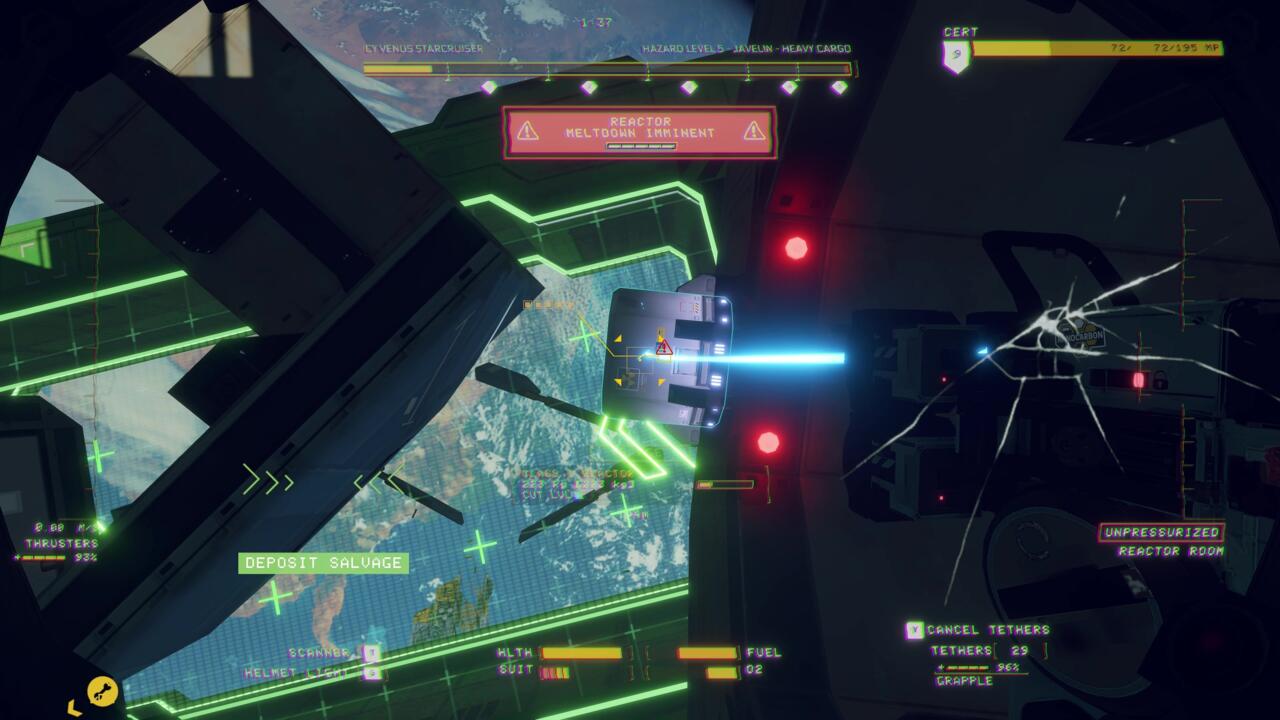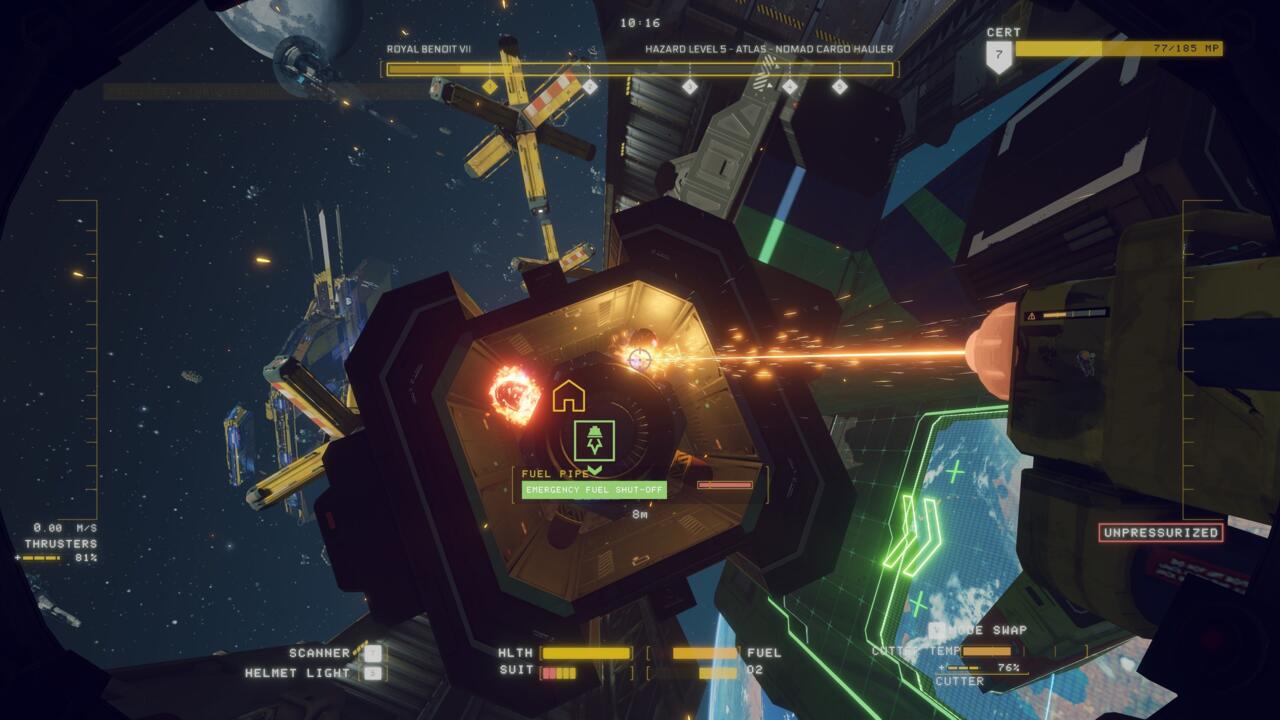Hardspace: Shipbreaker - How To Survive Radiation, Depressurization, And Other Hazards
Here's how to avoid becoming another piece of space debris.
Shipbreaking in Hardspace: Shipbreaker is a dangerous job, and it doesn’t help that these spacecraft seem to have been made with some questionable safety protocol. Reactors, pressurized cabins, electrical devices, explosive fuel tanks. One wrong move and you may be sending the whole ship into the furnace in pieces. That’s after Lynx Corp pulls another one of your clones from its petri dish and sends you back to work.
Here is a run-down of the hazards you will bump into in Hardspace: Shipbreaker and how to deal with them. Note that these aren’t the only things in the game that can kill you. Gravity is, and will forever be, your greatest enemy. However, knowing how to navigate the various temperamental systems of the various ships will improve your odds of surviving your shift.
Explosive depressurization
While explosive depressurization might not sound that scary from the sealed comfort of your spacesuit, it’s the explosive part you need to be afraid of. Explosive depressurization is when the atmosphere kept within a cabin of a ship is suddenly sucked out into the vacuum of space. Anything in the cabin is going to make a quick trip towards whatever hole you just made, and if you are hapless enough to be directly in its path, then you might get a closer look than you intended as it smashes through your visor.
In order to safely depressurize a ship, first, you need to safely enter through the airlocks. The airlocks ensure that any atmosphere within stays where it’s needed. You open the doors by cranking the lever next to them. Be careful, you can tear these panels right off, making a violent change in atmosphere your only option.
Once inside, you’re going to be looking for the atmospheric regulator, which looks a lot like a window-mounted air conditioner. Normally, these are found near the airlock. Once you activate one of these, the atmosphere will safely be drained. When done correctly, the right side of your screen will read “Unpressurized.” Be careful, though, some ships have multiple cabins that need to be depressurized individually. Don’t think that just because you toggled one regulator, it’s safe everywhere.

Reactors
While Hardspace: Shipbreaker will give you a heads-up before you start working on a ship whether or not it has a reactor present, you can always tell when you’re getting close because the radiation will mess with your HUD. The reactor should be a major priority for you, since it could become damaged and explode, taking out a huge portion of the ship in the process. It might be prudent to start with the reactor, as once it’s gone, you can breathe a bit easier.
There’s one thing to note with the reactor, and that is you may need to purge the fuel lines before pulling it. This is different for each reactor, but generally, you’re either looking for a lever or a computer console. Sometimes you can just go ahead and toggle these, flushing the lines and continuing with the removal, but other times you need to find the keys for them. These will be floating around somewhere within the ship, often near the cockpit.
Note that once you flush the lines, the reactor will go into meltdown, which means you need to fling it into the barge before time runs out. It’s a good idea to clear a path between the reactor and the barge before you touch it.
Also, keep in mind that some reactors aren’t connected to anything, and you can just pull them. You should be able to recognize when there are no fuel pipes present, but just in case, take a tour around the ship’s interior to look for any consoles or shut-off valves.
You will eventually hit Class II Reactors, which have a few more steps to their dance. You are able to simply clear a path to the barge, yank it, and fling it, but that doesn't leave much room for error. To extend how long you have before the reactor melts down, you'll first want to eject the thrusters, then go to the Environmental Control Unit and pluck out the canisters (see below). Note that the reactor won't even twitch when you hit the thruster ejection switch, but it will start its meltdown when you disable the ECU. Clear a path before you do this. Even though these actions will increase the amount of time you have to get the reactor in the barge, you need to work carefully. You can still bump the reactor too hard and it will go up like a Christmas tree.
Fuel Pumps
You can imagine fuel pumps to be a lot like reactors, but usually, there are fewer safety measures in place. Atlas ships in particular have a design where the fuel cut-off is located behind the thruster. This requires you to cut the four pipes connected to the thruster, then quickly pull it out of the way. You then have precious little time to make your way through the nacelle, past the erupting gas and fire, and hit the cut-off. The danger isn’t over, however. The two halves of the nacelle pop apart, which can cause you to get thrown around or crushed. This can be deadly, so it might be a good idea to hold on using your grabby hands until the danger passes.
Removing the thruster and cutting the fuel may be the most dangerous procedure in Hardspace: Shipbreaker. Just stay calm, avoid the fire, and work fast.

Electrics
It’s a bit easier to deal with electrical devices just by not being near them when you’re dismantling them. However, there are ways to make the whole endeavor a lot safer. For example, if you follow the wires around the ship, you’ll often come across the odd junction where a power cell is sitting. Plucking this (from a safe distance) will reduce the chances of the wires themselves arcing when you cut their junctions or pull them from the wall.
The bigger ships also may have fuse boxes scattered around their cabins. It’s very important to find these and turn them off before mucking around with anything electrical. Failure to do so might be quite shocking. To do so, simply remove the fuse when the blinking red lights that border it are off.
Once all the fuses are removed, everything, including the power generator, should be safe to remove without electricity arcing everywhere.
Environmental Control Unit
Out of all the things that can kill you in space, this one is probably the least deadly. It’s also one of the easiest to handle. While you’re doing your initial ship inspection, if you come across an Environmental Control Unit, it’s simple to dismantle. Simply pull off the front panel and rip out all the canisters. That’s all there is to it. Nothing is going to explode in your face if you go too slowly.
Got a news tip or want to contact us directly? Email news@gamespot.com
Join the conversation